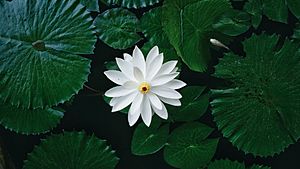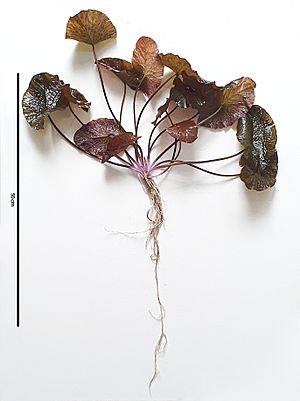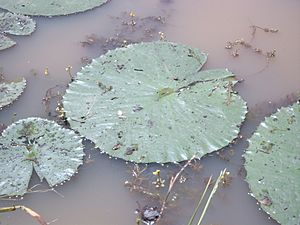Nymphaea lotus facts for kids
Quick facts for kids Nymphaea lotus |
|
|---|---|
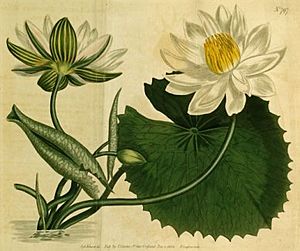 |
|
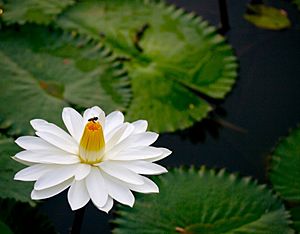 |
|
| Conservation status | |
| Scientific classification | |
| Genus: |
Nymphaea
|
| Species: |
lotus
|
| Varieties | |
|
|
| Synonyms | |
|
Nymphaea dentata Schumach. |
|
The white Egyptian lotus, also known as the tiger lotus or Egyptian water-lily, is a beautiful flowering plant. Its scientific name is Nymphaea lotus. It belongs to the Nymphaeaceae family, which includes many water lilies.
Contents
Where the White Lotus Grows
This amazing plant grows naturally in different parts of East Africa and Southeast Asia.
How It Was Introduced
The white lotus was brought to Western gardens in 1802 by a nursery called Loddiges. Later, a gardener named Eduard Ortgies created the first hybrid water lily. He did this by crossing Nymphaea lotus with another type of water lily. Today, it is a popular ornamental plant in places like Venezuela.
What the White Lotus Looks Like
This type of water lily has large, round leaves called lily pads. These pads float on the water's surface. Its beautiful blossoms rise up above the water.
The plant is a perennial, meaning it lives for more than two years. It can grow up to 45 centimeters (about 18 inches) tall. The flowers are usually white, but sometimes they have a light pink color.
White Lotus in Nature
You can find the white lotus in ponds. It prefers clear, warm, still, and slightly acidic water. It often grows alongside other water plants, like Utricularia stellaris.
The Nymphaea lotus has a special ability. It can survive through dry seasons using its underground stems, called rhizomes. It can also help reduce water evaporation from ponds by up to 18 percent during hot summer days.
How People Use the White Lotus
As an Aquarium Plant
The Nymphaea lotus is often used as a plant in freshwater aquariums. People who keep aquariums usually trim the floating lily pads. They do this to keep only the underwater leaves. This helps the plant grow better in the aquarium. If you want the "red" types to have a deep reddish color, they need very strong light.
Under bright light, the leaves can show tiger-like patterns.
As a Symbol
In ancient times, the Egyptian lotus was highly respected, especially in Egypt. It was seen as a symbol of creation. In Ancient Greece, it stood for innocence and modesty.
The Egyptian lotus is the national flower of Egypt. The designer Claire Waight Keller even included this flower to represent Malawi in Meghan Markle's wedding veil. The veil featured special flowers from each Commonwealth country.
As Food
In some parts of Africa, people eat the rhizomes and tubers (underground parts) of the plant. They are full of starch. People boil, roast, or grind them into flour after drying. Young fruits are sometimes eaten in salads. The seeds can also be made into a meal.
In India, the tubers or seeds are sometimes used as a famine food during times when other food is scarce.
The White Lotus in Ancient Egypt
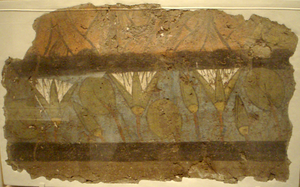
The ancient Egyptians grew the white lotus in their ponds and marshes. This flower often appeared in their decorations. They believed the lotus flower gave them strength and power. Parts of the flower have even been found in the burial tomb of Ramesses II.
Ancient Egyptian tomb paintings from around 1500 BC show some of the earliest examples of ornamental gardens. These paintings show lotus ponds surrounded by neat rows of acacia and palm trees. In Egyptian stories, the god Horus was sometimes shown as a boy sitting on a lotus with his mother.
The lotus was also one of the first designs used for column tops in Egyptian buildings. The symbol for the number 1,000 in ancient Egyptian numerals is the white lotus:
|
|
The ancient Egyptians also made perfume from this flower. They used the white lotus in funeral garlands, as offerings in temples, and for women's decorations. Some historians think the white lotus might be the plant eaten by the Lotophagi (Lotus-Eaters) in Homer's famous story, the Odyssey.
Health Effects
The plant contains a chemical called nupharin. While some sources say it might be poisonous, others say it has no harmful effects. People have eaten parts of this plant since ancient times.



